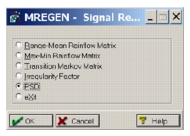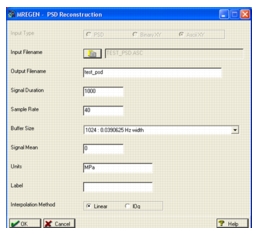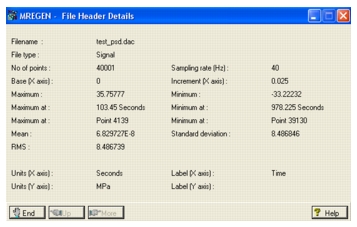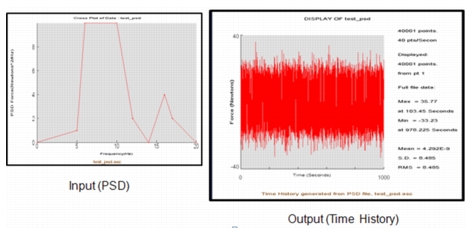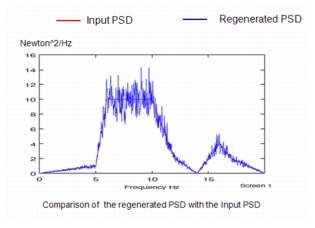XXXXXXXXXXXXXXXXXXXXXXXXXXXXXXXXXXXXXXXXXXXXXXXXXXXXXXXXXXXXXXXXXXXXXXXXXXXXXXXXXXXXXXXXXXXXXXXXXXXXXXXXXXXXXXXXXXXXXXXXXXXXXXXXXXXXXXXXXXXXXXXXXXXXXXXX''"> File Conversion Utilities
Six file translation utilities exist in MSC.Fatigue. These utilities can be invoked from the system prompt or can be selected from the Tools | MSC.Fatigue | File Conversion Utilities pull-down menu (for Patran) or from the Tools | Fatigue Utilities | File Conversion Utilities pull-down menu (for Pre & Post).
Convert Binary .dac to ASCII - MDTA and Convert ASCII to Binary .dac - MATD
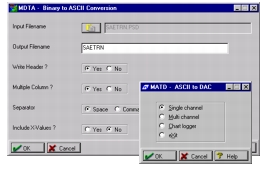
MDTA converts standard MSC.Fatigue .dac files into ASCII form. This can also be done using the MCOE. The difference is that MDTA can be run in batch mode and MCOE cannot.
MATD converts ASCII files into standard MSC.Fatigue .dac files. This can also be done using PTIME. The difference is that MATD can also process multi-channel ASCII files, thus creating multiple .dac files from a single ASCII input file. Both run in batch mode for easy processing of multiple ASCII files.
Signal Regeneration - MREGEN
MREGEN will take a three dimensional (three parameter) histogram matrix and will regenerate the time signal from it. The resulting time signal is statistically equivalent to the original in that it will give the same cycle count.
As an example of this, take the SAE signal
saetrn.dac and run it through MSLF as in the section on MSLF in this chapter. This will create a cycles histogram file called
saetrn.cyo. Use the Range-Mean Rainflow Matrix option to convert it to a time signal. Be sure to give it another output file name so as not to overwrite the original signal. Plot the new signal vs. the old signal using MMFD (multi-file display).

As a final exercise you might want to run the new signal through MSLF and then compare the new rainflow cycle count matrix to the old. They should look almost identical in nature. Use MP3D to plot each .cyo file.
Note: | The life estimate may not be the same because the scale factor is not applied to the cycles file. Scale the time history (using MART or PTIME) in order to use a scale factor of 1.0 to create the cycles file in MSLF. Then run this through MREGEN. |
Convert RPC File to .dac - MREMDAC and Convert .dac to RPC file - MDACREM
MREMDAC is used to convert an MTS RPC (remote parameter file -
.rsp) into a set of MSC.Fatigue compatible
.dac files. MDACREM is used to take a set of
.dac files and convert them back into an MTS RPC file.

These files come from data accumulated in MTS test simulation machines.
Convert PSD File to Time History (.dac)
MREGEN can be used to convert a PSD file into a time history (.dac) whose PSD will approximately match that of the input PSD.
As an example, let us convert the PSD data contained in the ascii file, test_psd.asc (located in the folder P3_HOME/mscfatigue_files/examples) into a time history file.
Launch the Signal Regeneration module (Tools > MSC.Fatigue > File Conversion Utilities > Signal Regeneration (or from a command window, type mREGEN).
From the interface shown above, select PSD and click on OK, to bring up the MREGEN - PSD Reconstruction form shown below.
Input Type: Inputs can be an MSC/nCode format PSD file (e.g. generated by
MASD) or a Binary or ASCII XY file. Select Ascii XY
Input Filename: Select the file test_psd.asc
Output Filename: Accept the default output filename (test_psd.psd)
Signal Duration: Enter 1000 as the signal duration time (in seconds). The default Duration does not give an accurate representation of the input PSD. The longer the duration of the sample, the better will be the generated time history.
Accept the defaults for all the other options, and click OK. A screen providing the header details of the dac file, as shown below, will be displayed.
Click on End, to complete the regeneration.
Plots of the input file, and the regenerated time history file are shown below.
As an exercise, recreate the PSD from the regenerated time history, and compare it with the input psd. The comparison should be something like the one shown below.
Cross Platform Conversion - MCONFIL
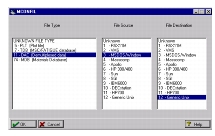
MCONFIL is a utility to convert standard MSC.Fatigue type binary files for cross-platform compatibility. For example, if you created or acquired a number of time signals as .dac files on a PC and needed to transfer them to a UNIX workstation you would need to run all the .dac files through CONFIL to byte swap them. Other files that are necessary to convert using MCONFIL are ptime.tdb, the time history database file, nmats.mdb, the materials database file, and any compliance functions with extension .ksn as well as any other one, two or three parameter files.
Waterfall File Create - MWFLCRE
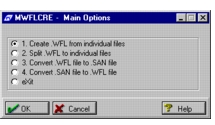
MWFLCRE allows creation of waterfall plots from multiple single parameter files. For example, say you had a PSD plot for each RPM of a motor from 1100 RPM to 4500 RMP in 50 RPM increments. You could combine all RPM PSD plots into a single three parameter waterfall plot with this utility. Conversely, you can break waterfall plots up into individual single parameter history plots. Three parameter plots can be displayed using the MP3D graphic utility.



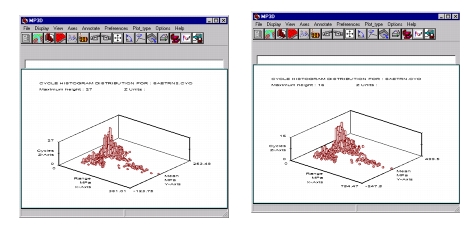
 These files come from data accumulated in MTS test simulation machines.
These files come from data accumulated in MTS test simulation machines.